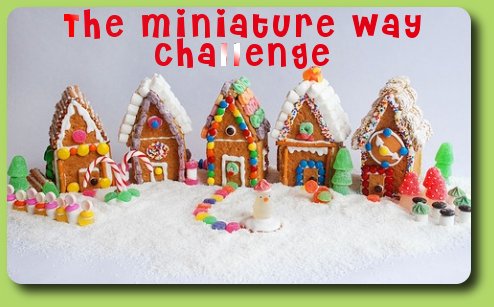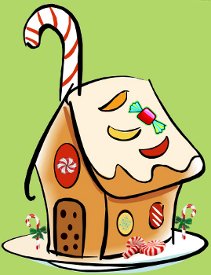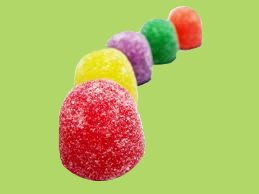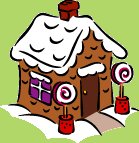
November 2010, Issue 10
Calling All Gingerbread Houses
Page 31

Calling all mini bakery builders for a sugar and spice and everything nice challenge!
The First Annual 1:12th or Smaller Miniature CDHM Gingerbread House Challenge is here!
 CDHM is looking for 1:12 scale or smaller gingerbread houses as an early kick-off to The Miniature Way's Rockin' Around the Christmas Tree Holiday issue. In celebration of our fun-packed Christmas issue, participants can vie for the title of 'Master Mini Gingerbread House Maker' and a feature story of their very own to be published in the January issue. To increase your chances of being selected, please take the best quality photos of your original work possible and send to
by November 14.
CDHM is looking for 1:12 scale or smaller gingerbread houses as an early kick-off to The Miniature Way's Rockin' Around the Christmas Tree Holiday issue. In celebration of our fun-packed Christmas issue, participants can vie for the title of 'Master Mini Gingerbread House Maker' and a feature story of their very own to be published in the January issue. To increase your chances of being selected, please take the best quality photos of your original work possible and send to
by November 14.

Need inspiration? Miniatures and gingerbread houses are close to the same scales. Even people who aren't familiar with the miniatures hobby know all about gingerbread houses. And who doesn't remember the hexenhaeusle (the witch's luscious gingerbread house) in Hansel and Gretel? History has it that this imaginative house from fairy tale land is the house that started it all.
The Brothers Grimm fable, a cautionary tale for children to mind their parents, featured a house deep in the woods constructed entirely of sweets, with gingerbread for walls and icing and sweets for the trim and roof.
Granted, that house was constructed as a lure for disobedient children by a crafty old witch with a child-tooth instead of a sweet-tooth, but the gingerbread house has evolved into a sweet lure for children and adults alike.
So what about the gingerbread used to build these sweet sculptures? How the spicy sweet bread came to be is an interesting bit of cooking history.
Like other precious spices, ginger was a valuable commodity in the ancient world. The Indo-Malaysian spice is not only capable of adding warm zestiness to food but had medicinal value for calming upset stomachs.

All varieties of cakes, cookies and candies, as well as many savory dishes like curries, have incorporated ginger for several thousand years. The first known ginger creation was a gingered honey cake made by the Romans. But it took the Germans to transform the basic honey cake recipe and elevate ginger's use to an art form.
By the 15th century, baking gingerbread was considered to be such an art in Germany that it was only created within the confines of Guilds overseen by master bakers. The Guild of Nuremberg, Germany, was noted especially for creating some of the finest gingerbread decorated in gold paint or icing.
The Nuremberg Guild's creations were so fine they were even considered viable payment for taxes as well as a gift worthy of royalty! Gingerbread bakers everywhere had stiff competition for their wares, which proved to be very popular at fares, festivals and feasts across Europe.

The German Brothers Grimm gave bakers everywhere - master and otherwise - a new level of competition with their imaginative story of a house built completely from treats. It didn't take long before miniature versions that could be eaten without fear of witchy retribution were assembled using stiff, fragrant cakes of gingerbread and embellished within an inch of their existence with sugar, icing, candies and cookies of all kinds.
The Lebkuchenhaeusle, known in English as the gingerbread house, has now become a staple of many Christmas festivities. Challenges for the most creative, to most fragrant, most elaborate and more abound.
The list of Challenges now includes the first-ever 1:12th or Smaller Miniature CDHM Gingerbread House Challenge! Can you add your name to the ranks of master bakers who have claimed a title from their creative efforts? It's an even more impressive list including White House chefs.

When John Adams became the first president to move into the newly built White House in 1800, the presidential Christmas celebration included an elaborate gingerbread version of the house built over the course of 3 weeks using 80 pounds of gingerbread and 30 pounds of chocolate - among other multiple pounds of ingredients.
For the CDHM version of mini gingerbread houses the sky is the limit. Wood, paper, clay, jewelry findings, fabric - whatever you like to use to craft minis, put it in or on your mini gingerbread house. Who knows, your name might join those of other master Lebkuchenhaeusle creators as the chosen miniaturist of the very first CDHM Challenge. Good luck, and don't forget - all potentially selected pictures must be sent to by November 14, 2010! Images should not have watermarks or be grouped together.
The newly crowned Mini Master Baker will be featured in the December 2010 issue of CDHM The Miniature Way.
Custom Dolls, Houses & Miniatures / CDHM







